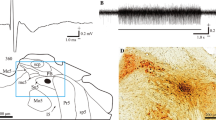Abstract
A microelectrode technique was used to study the neuronal mechanisms of motor signal transmission in the ventrooral internus nucleus (Voi) of the motor thalamus during voluntary and involuntary pathological (dystonic) movements in patients with spasmodic torticollis. Voi cell elements proved highly reactive to various functional (mostly motor) tests. An activity analysis of 55 Voi neurons detected during nine stereotactic operations revealed, first, a difference in neuronal mechanisms of motor signal transmission for voluntary movements that do or do not involve the affected axial muscles of the neck and for passive and abnormal involuntary dystonic movements. Second, a sensory component was found to play a key role in the mechanisms of sensorimotor interactions during voluntary and involuntary dystonic head and neck movements activating the axial muscles of the neck. Third, rhythmic and synchronized activity of Voi neurons was shown to play an important role in motor signal transmission during voluntary and passive movements. The Voi nucleus was directly implicated in the mechanisms of involuntary head movements and tension of the neck muscles in spasmodic torticollis. The results can be used to identify the Voi nucleus of the thalamus during stereotactic neurosurgery in order to select the optimal destruction or stimulation target and to reduce the postoperative effects in spasmodic torticollis patients.
Similar content being viewed by others
References
Percheron, G., Francois, C., Talbi, B., et al., The primate motor thalamus, Brain Res. Brain Res. Rev., 1996, vol. 22, p. 93.
Krack, P., Dostrovsky, J., Ilinsky, I., et al., Surgery of the motor thalamus: Problems with the present nomenclatures, Mov. Disord., 2002, vol. 17, no. 3, p. S2.
Ilinsky, I.A. and Kultas-Ilinsky, K., Motor thalamic circuits in primates with emphasis on the area targeted in treatment of movement disorders, Mov. Disord., 2002, vol. 17, no. 3, p. S9.
Hamani, C., Dostrovsky, J.O., and Lozano, A.M., The motor thalamus in neurosurgery, Neurosurgery, 2006, vol. 58, p. 146.
Kuramoto, E., Fujiyama, F., Nakamura, K.C., et al., Complementary distribution of glutamatergic cerebellar and GABAergic basal ganglia afferents to the rat motor thalamic nuclei, Eur. J. Neurosci., 2011, vol. 33, p. 95.
Nakamura, K., Sharott, A., and Magill, P., Temporal coupling with cortex distinguishes spontaneous neuronal activities in identified basal ganglia-recipient and cerebellar-recipient zones of the motor thalamus, Cerebral Cortex, 2014, vol. 24, no. 1, p. 81.
Van Donkelaar, P., Stein, J.F., Passingham, R.E., and Miall, R.C., Neuronal activity in the primate motor thalamus during visually triggered and internally generated limb movements, J. Neurophysiol., 1999, vol. 82, no. 2, p. 934.
Kurata, K., Activity properties and location of neurons in the motor thalamus that project to the cortical motor areas in monkeys, J. Neurophysiol., 2005, vol. 94, p. 550.
Hassler, R. and Dieckmann, G., Stereotactic treatment of different kinds of spasmodic torticollis, Confin. Neurol., 1970, vol. 32, p. 135.
Loher, T.J., Pohle, T., and Krauss, J.K., Functional stereotactic surgery for treatment of cervical dystonia: Review of the experience from the lesional era, Stereotact. Funct. Neurosurg., 2004, vol. 82, p. 1.
Schaltenbrand, G. and Baily, P., Introduction to Stereotaxic with an Atlas of the Human Brain (Stuttgart, Thieme, 1959).
Sedov, A.S. and Raeva, S.N., Wavelet analysis used to study firing activity of neurons of the human brain, Neiroinformatika, 2007, vol. 2, no. 1, p. 77.
Anderson, M.E. and Turner, R.S., Activity of neurons in cerebellar-receiving and pallidal-receiving areas of the thalamus of the behaving monkey, J. Neurophysiol., 1991, vol. 66, p. 879.
Kha, H.T., Finkelstein, D.I., Tomas, D., et al., Projections from the substantia nigra pars reticulata to the motor thalamus of the rat: Single axon reconstructions and immunohistochemical study, J. Comp. Neurol., 2001, vol. 440, p. 20.
Vitek, J.L., Ashe, J., DeLong, M.R., and Kaneoke, Y., Microstimulation of primate motor thalamus: Somatotopic organization and differential distribution of evoked motor responses among subnuclei, J. Neurophysiol., 1996, vol. 75, p. 2486.
LeDoux, M.S. and Brady, K.A., Secondary cervical dystonia associated with structural lesions of the central nervous system, Mov. Disord., 2003, vol. 18, p. 60.
Munchau, A. and Bronstein, A.M., Role of the vestibular system in the pathophysiology of spasmodic torticollis, J. Neurol. Neurosurg. Psychiatry, 2001, vol. 71, p. 285.
Slézia, A., Hangya, B., Ulbert, I., and Acsády, L., Phase advancement and nucleus-specific timing of thalamocortical activity during slow cortical oscillation, J. Neurosci., 2011, vol. 31, p. 607.
Raeva, S.N., Lukashev, A.O., Kadin, A.L., et al., Time course of neuronal interactions in the thalamic reticulate nucleus of the human brain at speech stimuli varying in signal importance, Neirofiziologiya, 1990, vol. 22, p. 451.
Raeva, S.N., Role of the parafascicular complex (CMPf) of the human thalamus in the neuronal mechanisms of voluntary attention, Ros. Fiziol. Zh. im. I.M. Sechenova, 2005, vol. 91, p. 225.
Sedov, A.S., Medvednik, R.S., and Raeva, S.N., Neuronal mechanisms of voluntary and involuntary movements in the thalamic parafascicular complex (CM-Pf) of spasmodic torticollis patients, Ros. Fiziol. Zh. im. I.M. Sechenova, 2010, vol. 95, no. 5, p. 498.
Livanov, M.N., Spatial Organization of the Brain (Nauka, Moscow, 1972).
Contreras, D. and Steriade, M., Synchronization of low-frequency rhythms in corticothalamic networks, Neuroscience, 1997, vol. 76, p. 11.
Tang, J.K., Mahant, N., Cunic, D., et al., Changes in cortical and pallidal oscillatory activity during the execution of a sensory trick in patients with cervical dystonia, Exp. Neurol., 2007, vol. 204, p. 845.
Author information
Authors and Affiliations
Corresponding author
Additional information
Original Russian Text © A.S. Sedov, S.N. Raeva, V.B. Pavlenko, 2014, published in Fiziologiya Cheloveka, 2014, Vol. 40, No. 3, pp. 28–35.
Rights and permissions
About this article
Cite this article
Sedov, A.S., Raeva, S.N. & Pavlenko, V.B. Neuronal mechanisms of motor signal transmission in the thalamic ventrooral nucleus in spasmodic torticollis patients. Hum Physiol 40, 258–264 (2014). https://doi.org/10.1134/S0362119714030153
Received:
Published:
Issue Date:
DOI: https://doi.org/10.1134/S0362119714030153



